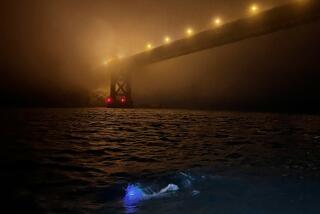Sailor Undaunted by Poor Health in Attempt to Circle the Globe
- Share via
SEATTLE — A solo American sailor who became ill near the Falkland Islands and had to be rescued by the British Navy said Monday that she hopes to return to her boat next week to resume her effort to circle the globe.
Karen Thorndike, 54, of Snohomish, Wash., completed about a third of her journey in an attempt to become the first American woman to sail solo around the world when she began suffering severe chest pains during a storm four days after leaving the Falklands.
Although she initially feared a heart attack, Thorndike said she was consulting cardiac specialists in Seattle after a preliminary diagnosis of angina.
“I feel pretty good,” said Thorndike. “If I get a clean bill of health, I’ll go back to the Falklands and continue on.”
Although she hoped to return next week, Thorndike said she already has lost her window of opportunity to cross the South Atlantic this year and has only until April 1 to get her 36-foot sloop, Amelia, out of the Falklands ahead of approaching winter storms.
At a news conference in Seattle, Thorndike said the fate of the Amelia was her top concern even when she was in pain. Weakened and dehydrated from the flu, she said she worked for 90 minutes in a howling gale to take down the sails and save her boat.
“And then the chest pain started, and it was massive,” she said. “I got the boat under control and I went down and felt like I was not going to make it.”
She sent a distress call to John Oman, a Seattle sailor acting as her home base who was able to pass the message to the British Coast Guard in less than an hour.
Meanwhile, the stricken Thorndike had to leave her cabin about every 30 minutes to get the boat under control as the storm overpowered the craft’s self-steering mechanism.
About 15 hours later, the sloop was approached by an inflatable boat launched from the frigate Norfolk, which had sailed 100 miles to rescue Thorndike. Two sailors jumped aboard and put a protective helmet on the delirious Thorndike and then had to push her off the Amelia and into the boat, which motored back to the 300-foot-long ship.
Thorndike, a film and television script supervisor, credited Oman, the British Navy and a sophisticated satellite communication system with saving her life.
Thorndike said she was grateful the captain of the Norfolk allowed four crew members to sail the undamaged Amelia back to Port Stanley, 300 miles away. Under the law of the sea, the sailboat could have been sunk instead after its sole occupant was rescued.
Thorndike left San Diego in August and sailed to Port Stanley via Hawaii and Tahiti. She hopes to complete her voyage in April 1998, nearly a year behind schedule.
More to Read
Sign up for Essential California
The most important California stories and recommendations in your inbox every morning.
You may occasionally receive promotional content from the Los Angeles Times.










